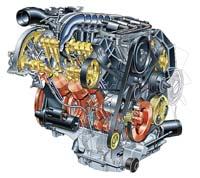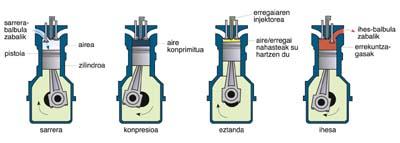Internal combustion engine

The engine of the first internal combustion was built by Francois Issac de Rivaz in 1807. The truth is that it was not useful, as it did not generate mechanical forces and also used a mixture of hydrogen and oxygen for fuel. Keep in mind that clarification and accumulation of hydrogen is not easy and that this requires more energy than is produced.
Years later, on April 1, 1826, Samuel Morey patented the engine of the first internal combustion. He used ethyl alcohol and turpentine mixed for fuel. At that time, turpentine was used to color the flame of alcohol. He placed and used the engine in a “vehicle” as a car and in a small container. The boat toured the Connecticut River at an approximate speed of 15 km/h. However, Samuel did not get enough funding to develop his invention and remained.
Years later, in 1858, Jean Lenoir invented a more efficient internal combustion engine using fuel coal gas. Coal gas was widely used in urban lighting systems before it dominated electricity.
Until then they were single-cylinder and two-stroke engines.
However, the most significant advance occurred in 1867. That year, Nicolas Otto manufactured a four-stroke internal combustion engine. More effective than the Lenoir model, it triumphed in its industrial launch. Subsequently, Gottlieb Daimler began to use this engine in the automotive sector, especially from the incorporation of gasoline carburetor. That is, since he added the device to properly mix air and fuel. Most current cars do not have carburetors as they use an injection system to mix fuel with air.

In 1890 Wilhelm Maybach made for the first time a four-cylinder internal combustion engine.
Both Gottlieb Daimler and Wilhelm Maybach were workers of the company of Nicholas Otto, but in 1882 they founded their company.
XIX. At the end of the 20th century the current model of internal combustion engines had been invented, since then only adjustments and adaptations have been made.
Apps
The internal combustion engine transforms heat energy into mechanical energy through controlled explosion inside the engine. It is especially useful for propulsion systems that move from one to the other. In land, sea and air vehicles (cars, trains, ships, planes...)
in addition to its use in construction, industry, agricultural machinery, electricity production, etc. However, the competition of electric motors is very hard, especially in the industry and in applications that do not move in one way or another.
Structure and operation
The most important part of these engines is the combustion chamber. It is where fuel is burned and, consequently, where heat energy is generated. Subsequently, heat energy is transformed into mechanical energy through the mechanical components of the engine.
Spark ignition engines (Otto engines) and compression ignition engines (Diesel engines) are two main types depending on the action of fuel fire. However, the main parts of both types of motors are equal. They can be engines of two or four times, but the most used are those of four times, that is, with input, compression, explosion and escape.


In the second stage --compression-- the piston rises. Since the inlet valve is already closed, the fuel air mixture is compressed in one case and the air in the other.
It follows the third time it explodes. In the Otto engines the electric spark of the spark plug bursts a very compressed mixture. In diesel engines, however, this third time the fuel is injected into the cylinder. As the air in the cylinder is very compressed, it is very hot and therefore the fuel explodes. Having a higher volume of the explosion gases, they push the piston down and that is when mechanical work is produced due to the linear movement of the piston.
The fourth stage consists of opening the exhaust valve and expelling the combustion gases with the piston in its lower position in flight.





